Including these Services for Free
Medical tests
Post-operative care
Visa and Travel insurance
Interpreter
Food for all days
Medical consultation
Airport Pick up/Drop off
SIM card
Shopping
Sightseeing Tours
Medicine
Follow up
VIP Transfer
Internet

Flora medical tourism facilitator offers all-inclusive Roux-en-Y Gastric Bypass Packages all across Iran(Tehran, Mashhad, Kish island, Shiraz, Tabriz, Esfahan, Yazd, Ahvaz, Sari…), for any budget.
7 Night Accommodation in Iran




Flora medical tourism facilitator only has partnerships with the best hotels.
We will reserve accommodation for you at up to 40% lower price than anywhere else.
ALL INCLUSIVE GASTRIC BYPASS PACKAGE IN IRAN from $2,600
What Is Roux-en-Y Gastric Bypass (RYGB)
Gastric bypass is a type of bariatric surgery that aims to change your digestive system to help you lose weight. A surgeon performs roux en y laparoscopically in order to create a small pouch in the stomach. This pouch will be created in the stomach for foods to pass through, and it is connected to the small intestine. Bypassing a large part of the stomach and duodenum restricts the amount of calories your body absorbs and results in weight loss. Because the pouch is too small to hold large amounts of food and the food skips the duodenum, fat absorption is substantially reduced after the bypass surgery. If diet and exercise haven’t worked for you or you have serious health problems because of your weight, roux en y is a great option.
Gastric Bypass Step by Step
1. Consultation for your Gastric Bypass in Iran
In this session, the surgeon will ask you what led you to seek out bariatric surgery and the specific goals you may have. He/she may also ask about what you’ve done in the past to lose weight. Another important factor is your body mass index (BMI). The surgeon calculates your BMI by dividing your weight by your height and squaring the result. BMI show if you are underweight, healthy weight, overweight, or obese.
This information helps your doctor to decide which procedure will be the best fit for you. The other topic that will be discussed in this session is the supervised diet process before surgery and the dietary changes you should expect after surgery. The surgeon will answer any questions you ask.
2. Gastric Bypass Surgery in Iran
There are two ways to perform gastric bypass. Open and laparoscopic
Open gastric bypass: With a large incision, the surgeon opens your belly. She/he works on your stomach, small intestine and other organs to do the bypass.
Laparoscopic gastric bypass: Another way to a gastric bypass is to use a tiny camera, called a laparoscope. The surgeon places the laparoscope in your belly which allows the surgeon to see inside your belly.
3. Recovery of your gastric bypass
Most gastric bypass patients need to stay in the hospital for two to three days or longer if complications develop. After 3 to 5 weeks the patients can get back to normal activities. Patients who undergo laparoscopic bariatric surgery usually need a shorter hospital stay and recovery time. To varying degrees, it is normal to experience nausea and vomiting, weakness, fatigue, loss of appetite and emotional ups and downs in the early days and weeks after surgery. Please discuss any concerns you have with the nurses and they will help you. Flora medical tourism facilitator’s nurses are united to provide whatever you need and ease your mind after the surgery. Flora will provide you with the most skilled and friendly nurses at any time you ask during your 7day stay in Iran. This agency will also prepare the medications and anything else you need.
4. Aftercare & Follow-up after Gastric Sleeve
We believe that the highest quality aftercare is as important as the surgery itself, so we are here to support you. During your stay in Iran, as well as providing skilled nurses, we will follow you up everyday and also we will keep contact between you and your surgeon. When you go back home, your gastric bypass surgeon will contact you around six weeks after your surgery in Iran to check on your progress and arrange any further aftercare you might need after you left Iran; and this periodic follow- up will continue until 2 years after your gastric bypass in Iran. It should be mentioned that you can cancel this free service whenever you want.
Find your Gastric Sleeve day by day Schedule in this Article
Is Iran a Wise Destination for Gastric Bypass?
There are numerous reasons why over 600,000 medical tourists travel to Iran, yearly. Here you can find some of the reasons.
- Affordability
Iran has earned itself the honor of being the most affordable country for gastric bypass surgery in the world. This is because of the low value of Rial compared with other currencies. A lot of people are very surprised to discover how affordable a gastric bypass surgery is in Iran. The cost of this surgery here in Iran is around three times lower than in the USA. You can have the roux en y surgery in Iran for as little as $3000.
- Experienced surgeons
The surgeons in Iran are extremely experienced in performing gastric bypass surgery and this, in turn, boosts the gastric bypass surgery success rate to more than 90%. The chances of an excellent result with minimal complications are very high when you choose Iran for your gastric bypass operation.
Another reason why Iran is so popular is that it is an ancient four-season country and a great choice for a relaxing holiday after your surgery. Iran has astonishing attractions.
- High tech facilities
Clinics and hospitals in Iran are very hygienic and safe. If you choose Iran as your destination country, you will undergo a satisfying gastric bypass in a luxurious hospital/clinic with all modern conveniences. Medical facilities in Iran are staffed by kind nurses and staff who are highly skilled and qualified.
How Much does a Roux-en-Y Gastric Bypass cost?
The prices of weight loss surgeries are slightly higher than other surgeries. Firstly, let’s list the factors that affect the price:
- The materials used in surgery
- The hospital where the surgery will take place
- Equipment and tools
- Expert surgeons
The cost of a gastric bypass surgery in Iran is much lower than any other country around the globe. While this procedure costs you around $3000 dollars in Iran, the same services will cost you $18000 dollars in the USA and $13000 dollars in the UK.
In the chart below we have put together a list of starting costs for different countries. Please keep in mind that these are not fixed and the final prices and they may vary depending on each patient’s individual needs and medical history.
| Country | Price |
| Canada | $20000 |
| United States | $18000 |
| Australia | $16000 |
| United Kingdom | $13000 |
| Thailand | $11000 |
| India | $7800 |
| Costa Rica | $7500 |
| Mexico | $6000 |
| Iran | $3000 |
 Types of Weight Loss Surgery
Types of Weight Loss Surgery
 Sleeve gastrectomy
Sleeve gastrectomy
In a sleeve gastrectomy, the surgeon removes about 75% of patient’s stomach so it is much smaller than before. This means you will feel full sooner so will reach your ideal size and stay shaped easily.
Gastric bypass
In gastric bypass surgical staples create a small pouch at the top of the stomach. The surgeon connects the pouch to your small intestine, bypassing the rest of the stomach.
This means it takes less food to make you feel full. So that, you will absorb fewer calories from the food you eat and also fewer vitamins. So you will need to take vitamins permanently after the surgery.
Intra-gastric balloon
An intra-gastric balloon, or gastroscopy, is a soft balloon filled with air or salt water. It is placed into your stomach using a thin tube passed down your throat.
This means you will not need or be able to eat as much before to feel full. But it is only a temporary measure and the surgeon usually leaves the balloon in for a maximum of six months.
Gastric band
A gastric band is a band that the surgeon places it around the stomach. It creates a small pouch towards the top.
It takes less food to fill the pouch, so you won’t eat as much as before to feel full. This band will need to be tightened a few times to get to the ideal tightness for you.
Roux-en-Y Gastric Bypass Techniques
There are two techniques for performing gastric bypass, open and laparoscopic. With open surgery, your surgeon makes a large surgical cut to open your belly and do the bypass.
With laparoscopic gastric bypass, there is no large upper midline abdominal incision. The surgery is done by the use of a tiny camera called laparoscope that is placed in the belly and helps the surgeon to see inside your belly.
Because of reducing the size of the surgical incision, laparoscopic gastric bypass leads to reduction in postoperative pain, lower rate of wound-related complications, and faster recovery. According to the latest research, laparoscopic bariatric surgery should be considered the new standard for the treatment of morbid obesity as long as the surgeon has passed the learning curve of the laparoscopic approach.
What Type of Doctor Performs Gastric Bypass?
Bariatricians, or bariatric surgeons, provide care for patients who suffer from obesity. A bariatric physician or bariatrician is a professional with specialized training in the field of bariatric medicine or medical weight management. Bariatric doctors help overweight and obese patients with diet, nutrition, exercise, behavioral therapy, medications, surgery, or any combination of these. Their goal is to help patients to prevent or find solutions to reverse the patient’s obesity.
Preparing for Roux-en-Y Gastric Bypass
Read the following to find out how to prepare for roux en y
Medical Tests
- Complete Blood Count (CBC)
- Urinalysis
- Chemistry Panel
- Chest X-ray
- Electrocardiogram
- Gallbladder ultrasound
- Pulmonary function testing
- Echocardiogram
- Sleep studies
- GI evaluation
- BMI calculation (weight in pounds divided by height in inches squared).
- Cardiology evaluation
- Psychiatric evaluation (if necessary)
Food and Drink
One week before the surgery, your diet consists of clear liquids, protein shakes, vegetable juice, lean meat and Soup broth. Remember that after midnight the night before surgery, you will not be able to eat or drink anything. The before and after surgery diet guideline is written in the following of this article.
Actions to take
- Shower either the night before or the morning of the surgery using a special type of antibacterial soap
- Leave jewelry, credit cards, and other valuables at home
- Don’t wear makeup, fingernail polish, perfume, deodorant, moisturizers, on the day of your surger
- Stop any nonsteroidal anti-inflammatory drugs (NSAIDs) like Motrin (ibuprofen), or Aleve (naproxen) 10 days before the surgery
- Begin a bowel cleansing preparation
- Bring the hospital pack (Floramed provides it for the patients). The items for your hospital bag are underwear, toothbrush, comb, glasses or contact lenses and a cell phone charger and a sleep mask.
The Roux-en-Y Gastric Bypass Procedure
-
Duration of the surgery
Roux en y gastric bypass takes approximately 1.5 hours, and the hospital stay is two to three days.
-
Anesthesia
Surgeons commonly use general anesthesia for laparoscopic bariatric surgery, but in selected cases epidural anesthesia may be a usable alternative to general anesthesia.
-
Creating the pouch
The surgeon divides the stomach into a large and a small portion. Then, he/she staple the small part together and makes a pouch
-
Making the bypass
The surgeon disconnects the new, small stomach pouch from the majority of the stomach and duodenum (first part of the small intestine). Then the surgeon connects it to the jejunum (a part of the small intestine). After a Roux-en-Y, food passes directly from the stomach into the jejunum, bypassing the duodenum.
-
The result
Surgeons perform roux en y through single-incision laparoscopic surgery and you will have one small scar hidden in your belly button. So, you should not be worried about the scars at all. You can feel the result that reaches its peak one year after surgery. And the results will definitely surprise you as roux en y, incomparably helps you to lose a significant amount of weight.
Who is a Good Candidate for Roux-en-Y Gastric bypass?
There are specific criteria for which patients are good candidates for gastric bypass surgery. You are an excellent candidate for roux en y if you:
- Have a BMI of 35 or greater
- Have obesity-related conditions such as diabetes, heart disease, or obstructive sleep apnea
- Tried non-surgical weight loss methods that have failed
- Have attempted to lose weight for 2 or more years
- Have been obese for at least three to five years
- Are able to follow the surgeon’s instructions
- Are willing to lose weight and maintain a long-term healthful lifestyle including dietary, exercise and medical requirements
- Do not addicted to drugs, alcohol or have other physical addictions
- Is an adult under the age of 65 and over the age of 18?
Who is not a good candidate for gastric bypass?
Patients with these characteristics are typically not good candidates for gastric bypass surgery:
- Are currently pregnant or may become pregnant in the next 1 to 1.5 years.
- Have certain medical conditions, including gastrointestinal disorders, severe pulmonary or cardiovascular disease, autoimmune disease, increased risk of bleeding or mental disorders.
- Are under 18 or over 65
You can contact Floramed’s consultants 24/7 and ask for a professional consultation.
 Gastric Sleeve vs. Gastric Bypass
Gastric Sleeve vs. Gastric Bypass
Gastric bypass and gastric sleeve surgery, both, are bariatric surgeries and aim to help you get rid of obesity. Here you can find the differences between these two surgeries.
- With a gastric sleeve, the surgeon permanently removes about 75 percent of your stomach. But with gastric bypass, the surgeon creates a small pouch by bypassing most of the stomach.
- After the gastric sleeve the new banana shaped pouch fills up quickly so you will feel full sooner with less amount of food you consumed before the surgery. After roux en y the food you eat will not go into some parts of your stomach and small intestine. And it results in less absorption.
- The chance of nutrient deficiency is less likely with the gastric sleeve surgery than with gastric bypass surgery because there is no malabsorption.
- On average, within 12 to 18 months, roux en y patients lose up to 80 percent of excess bodyweight and gastric sleeve patients lose up to 70 percent of their excess bodyweight.
- Unlike the gastric bypass, the sleeve gastrectomy is a permanent and non-reversible procedure.
- Gastric bypass is a two step procedure and more complicated than gastric sleeve surgery
- You may need to stay in the hospital for longer after a Roux en Y compared with gastric sleeve
- If you’re trying to control obesity-related conditions such as hypertension, diabetes, or sleep apnea, both are effective but gastric bypass surgery can be more effective than gastric sleeve surgery
- The more obese you are, the more seriously you should consider gastric bypass over gastric sleeve
- Gastric sleeve has a lower risk of dumping syndrome compared with gastric bypass.
We can give you a consultation to determine which procedure is right for you. Contact us HERE.
Roux-en-Y Bypass Advantages and Disadvantages
We have listed the advantages and disadvantages of a Roux en Y gastric bypass:
Advantages
- Patients with high risk medical conditions can undergo this surgery
- Gastric bypass is the best option for patients with severe obesity
- This surgery results in greater overall weight loss due to the tighter dietary restrictions and less caloric absorption
- It can resolve or reverse quickly 96% of health problems related to obesity
- After this surgery you will feel strong discomfort whenever you consume too much sugar, fat and carb and this results in healthier food choices
- Gastric bypass changes the hormones mean most patients have an immediate reduction in their need for diabetic medication and some are able to completely stop diabetic medication altogether
- This surgery tends to have the strongest effect on high blood pressure, high cholesterol, and other obesity related health issues
- You can lose on average 60-80% of excess body weight by the help of this surgery
Disadvantages
- It changes your anatomy permanently
- For the rest of your life, you should follow a restricted diet
- Dumping syndrome from eating foods high in sugar, calories and fat causes discomfort, 20-30 minutes of nausea, diarrhea, possibly vomiting, and overall weakness each time
- Although complications are rare, they are generally more serious than with other weight loss procedures
- The reduced absorption of vitamins and nutrients increases the risk of nutritional deficiency
- You should take vitamin and mineral supplementation for the rest of your life to prevent deficiency following surgery
- You are not allowed to take aspirin or other NSAIDS after surgery
Post operative Roux-en-Y Gastric Bypass instructions
Roux en Y aftercare is vitally important and must be considered more essential than any other bariatric surgery. That is why we listed the 3 important issues of diet, exercise and pregnancy in the following. Receiving a special aftercare, promote your recovery process and lower your risk of complications. Also, knowing the roux en y post-op rules & guidelines perfectly helps you to pass a safe procedure and get a better result.
Diet Before the roux en y surgery-Week 1
- Protein shakes or meal replacement shakes are the main parts
- Only sugar-free beverages are okay (sugar substitutes are okay).
- No caffeinated or carbonated beverages are allowed
- Soup broth with no solid pieces of food may be consumed.
- V8 and vegetable juice are permitted
- Extremely thin cream of wheat or cream of rice are acceptable
- One or two daily servings of lean meat and/or vegetables are permitted
Diet After the surgery
Day 1
You should drink one spoonful of clear liquids every half an hour for two hours. When the 2 hours is passed, drink one spoonful of clear liquids every 15 minutes until the end of the day. You are only able to consume clear liquids (and protein shakes depending on you surgeons decision) at this stage.
Day 2&3
On the second and third day of the surgery you’re still only permitted to consume clear liquids and protein shakers. You must drink two spoonfuls of a clear liquid every 15 minutes during the days 2&3.
Week 1
- Clear Liquids
You should drink 1 to 2 ounces of clear liquid per hour, until day 7. Clear liquids include: water, fat-free milk, fat-free broth, sugar-free Jello
- Protein
Your surgeon may want you to start protein shakes a few days after surgery. Depending on your surgeon’s suggestion, follow the guidelines.
Week 2&3
- Pureed Foods and Protein Shakes
At this stage, you have permission to consume liquefied sources of protein. You should have several small meals throughout the day. You need about 60-70 grams of protein (protein shakes, pureed meat/fish, egg whites) and about 64 ounces (about 8 glasses) of clear liquids (as defined in stage one) not counting the fluid in the pureed foods.
Week 4&5
- Soft Foods
Now you can add soft foods to your diet. If you can mash a food easily with a spoon, fork or knife, it means that this food is a good choice. Soft foods include: soft meats and cooked vegetables. 60-70 grams of protein and 64 ounces of fluid is still recommended daily, like before.
Week 6
- Solid Foods
Now is the time to start eating real food but this does not mean you get to eat whatever you want. You should follow a diet consisting of protein, vegetables, a limited amount of grains, and very little, if any, refined sugars for the rest of your life.
Supplements
You need to take over the counter vitamins and minerals for the rest of your life. You take these items daily:
- A multivitamin
- Calcium citrate; 2 or 3 doses with each dose ranging from 400 mg to 600 mg
- Vitamin D3; two 500 IU doses
- Sublingual B12 (500-1,000 mcg)
What to avoid?
- Caffeinated
- Carbonated beverages
- Refined sugars
- Simple carbohydrates
- Smoking
- Alcohol
Note: Ideally you should not smoke at all after roux en y surgery but If you must smoke again try to wait for at least 1 month. Also, you should avoid alcohol for the first six months after bariatric surgery.
Exercise after Gastric Bypass
- Not only Walking is forbidden but also it is beneficial to a faster recovery. You can walk within just a few hours after surgery
- You should not start strength training until at least 6 weeks after your surgery
- Avoid any type of exercise until two to three weeks after gastric bypass surgery
- After 6 months of the surgery, you should work toward 30 minutes of continuous exercise 3 to 5 days per week
- The following exercises are allowed after month 3: biking, swimming and aerobic fitness, training with dumbbells, weight bands, or gym machines to build muscle mass
- Interval training on a treadmill, varying speed and incline, for 45 minute, Hiking, running, or any other strenuous activity is allowed after 1 year of the surgery
Pregnancy after Gastric Bypass
- After gastric bypass, female patients should avoid pregnancy for 1 year to 18 months
- Surgeons recommend to wait for 1 to 2 years after bariatric surgery to get pregnant
- Gastric bypass patients who had problems getting pregnant or having periods before can find that they have a much easier time after surgery and this surgery often can help patients become pregnant
Risks and Side Effects Of Roux-en-Y Gastric Bypass
Any surgery, especially the bariatrics, carry some degree of risk. The more common side effects associated with gastric bypass include:
- Dumping syndrome, an unpleasant side-effect that may include vomiting, nausea, weakness, sweating, faintness and diarrhea
- Leak from staple lines
- Stenosis (narrowing of a passage, such as the stoma)
- Ulcers
- Acid reflux
- Anesthesia-related risks
- Dilation of esophagus
- Inability to eat certain foods
- Infection
- Obstruction of stomach
- Weight gain or failure to lose weight
- Low blood sugar
- Malnutrition
- Bowel obstruction
- Hernias
- Excessive bleeding
- Blood clots
- Lung or breathing problems
- Leaks in your gastrointestinal system
Remember that Floramed’s professional medical team will do their best for you to narrow down the risks to about zero.
Is Roux-en-Y Gastric Bypass Worth it?
Read the following and you will find out that gastric bypass is totally worth it.
- You may have very small or no visible scars left after gastric bypass surgery
- You can get back to normal activities in 3 to 5 weeks
- Studies show that gastric bypass surgery boasts the greatest weight loss among all types of bariatric surgeries. Patients can lose about 80% of their excess weight
- You can see the final results of roux en y surgery after 1 year (losing 80% of excess weight)
- You will lose a lot of weight very rapidly in the first few months. During the first 30 days after roux en y surgery, you can lose 5 to 15 pounds per week, on average.
- Gastric bypass can provide long-term weight loss and until you maintain your healthy lifestyle the weight won’t back
- If you choose Floramed as your medical tourism facilitator, this surgery will cost you only $2500
Gastric bypass revision
There are 3 reasons why patients may get gastric bypass revision surgery:
- Failure to lose enough weight
- Weight regain
- Medical complications
Gastric bypass is the most effective weight loss surgery. On average, roux en y patients lose up to 80% of their excess weight after surgery. However, not everyone can lose the same weight after gastric bypass surgery. Statistics have shown that about 15% of patients fail to achieve adequate weight loss or regain a critical amount of weight back after surgery.
However, it has an increased risk of complications, gastric bypass surgery revision is an option for these patients to lose more weight and control comorbidity. They can lose up to 75% of their excess body fat by undergoing gastric bypass revision.
How can I Get my Roux-en-Y Gastric Bypass Surgery Arranged with Flora Medical Tourism Agency in Iran?
Medical Facilitators are a huge help with arranging travel details. Flora medical tourism facilitator is a necessary means to ensure that you get the best care for your health issues in Iran. First you should send a request. Our consultant will contact you and guide you through all the process. When you decide to have gastric bypass surgery in Iran, FLORA medical tourism agency will arrange all the necessary clinical, travel and hospitality services.
FREQUENTLY ASKED QUESTIONS ABOUT GASTRIC BYPASS
What is roux en y hepaticojejunostomy?
The hepatic duct is the tubular channel that aids digestion. It carries bile from the liver to the small intestine. A hepaticojejunostomy is a surgical procedure in which a connection (anastomosis) between the hepatic duct and the jejunum is made. Jejunum is the middle portion of the small intestine. This technique is named the Roux-en-Y hepaticojejunostomy.
What does gastrojejunostomy mean?
Gastrojejunostomy is a surgical procedure that creates a direct connection (anastomosis) between the stomach and the middle part of the small intestine (jejunum), bypassing or removing the beginning part of the small intestine (duodenum). This procedure is usually done to drain the contents of the stomach or to provide a bypass for the gastric contents.
What does anastomosis mean?
Anastomosis means a surgery in which two structures are connected. This surgery connects tubular structures, such as blood vessels or loops of the intestine. For instance, when in a surgery, the surgeon removes part of an intestine, the two remaining ends are sewn or stapled together (anastomosed).
What does gastrectomy mean?
A gastrectomy is a partial or total removal of the stomach, by surgery. With a partial gastrectomy, a part of the stomach is removed and with a full gastrectomy, the entire stomach is removed. Gastrectomy is used to treat stomach problems that aren’t helped by other treatments. Your doctor may recommend a gastrectomy to treat: noncancerous, benign, tumors. bleeding or obesity.
What does roux en y reconstruction surgery mean?
Roux en y reconstruction surgery is a mixture of several surgeries. With the gastrectomy reconstruction, the surgeon removes the excess skin and fat remaining. If the surgeon deems it necessary to tighten, lift and contour sagging areas for a more proportionate appearance, she/he will combine reconstructive and cosmetic techniques.
What is roux en y choledochojejunostomy?
Roux en y choledochojejunostomy is a procedure for creating an anastomosis of the common bile duct (CBD) to the jejunum. This surgery aims to relieve symptoms of biliary obstruction and restore continuity to the biliary tract.
What is roux en y pancreaticojejunostomy?
pancreaticojejunostomy surgery is a procedure that connects the pancreatic duct and the jejunum. Pancreaticojejunostomy is an achievable, safe and effective surgical procedure for chronic pancreatitis patients. This surgery is also called puestow procedure.
What is pancreatic cystojejunostomy?
Cystojejunostomy is a surgical anastomosis of a pancreatic cyst to the jejunum. Cystojejunostomy is done in case of symptomatic cysts, rapidly enlarging or complicated cysts.
What does duodenum mean?
Duodenum is the top part of the small intestine. This part is located between the stomach and the middle part of the small intestine, or jejunum. When you eat, foods mix with stomach acid. After this mixture, they move into the duodenum, where they mix with bile from the gallbladder and digestive juices from the pancreas.
What is roux en y limb?
Roux en y limb is a surgical anastomosis of bowel used to reconstruct the gastrointestinal tract. Usually, it is between the stomach and small bowel that is distal (or further down the gastrointestinal tract) from the cut end.
What is roux en y esophagojejunostomy?
Esophagojejunostomy means a surgical formation of an artificial communication between the esophagus and the jejunum.
What does roux en y mean?
Roux en y or gastric bypass is a type of bariatric surgery which aims to help patients lose weight. With this surgery, the surgeon creates a small pouch from the stomach and connects the newly created pouch directly to the small intestine. This leads to less absorption and fast weight loss.
Is roux en y reversible?
If you have failed to lose weight or regained weight due to a stretched stomach pouch or enlarged stomach outlet don’t worry. Although this is rarely required, gastric bypass can be reversed,
Is roux en y gastric bypass safe?
However any surgery has risks, bariatric surgeries such as gastric bypass are very safe to undergo. Bariatric surgeries are safer than any other elective surgery.

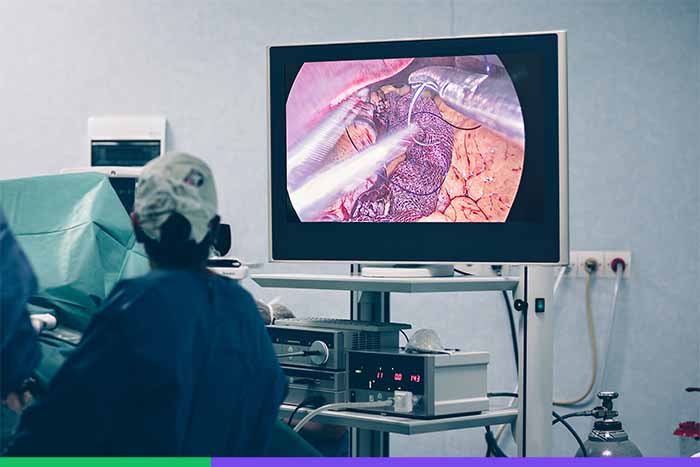


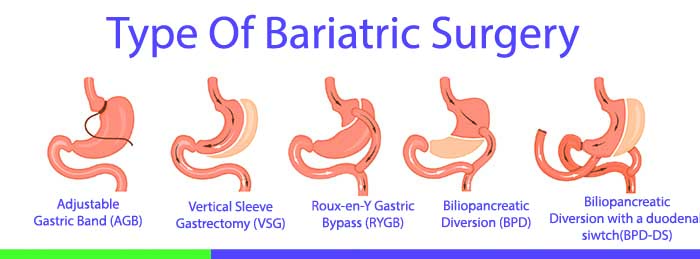 Types of Weight Loss Surgery
Types of Weight Loss Surgery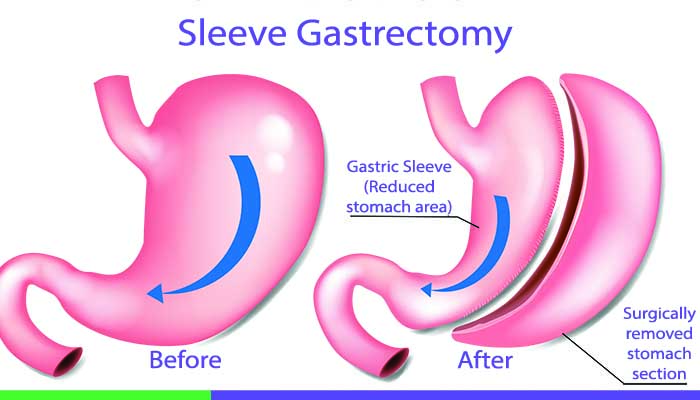 Sleeve
Sleeve 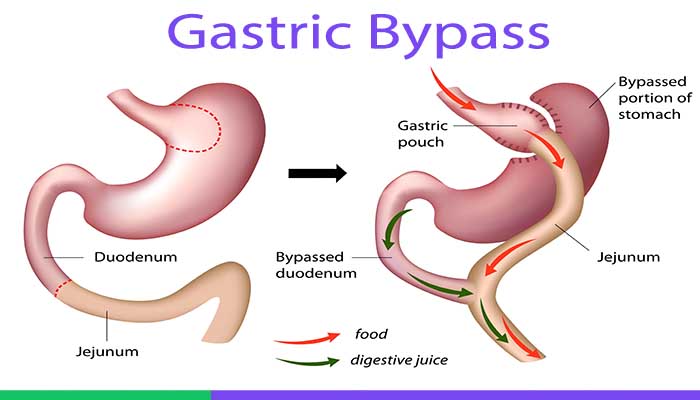

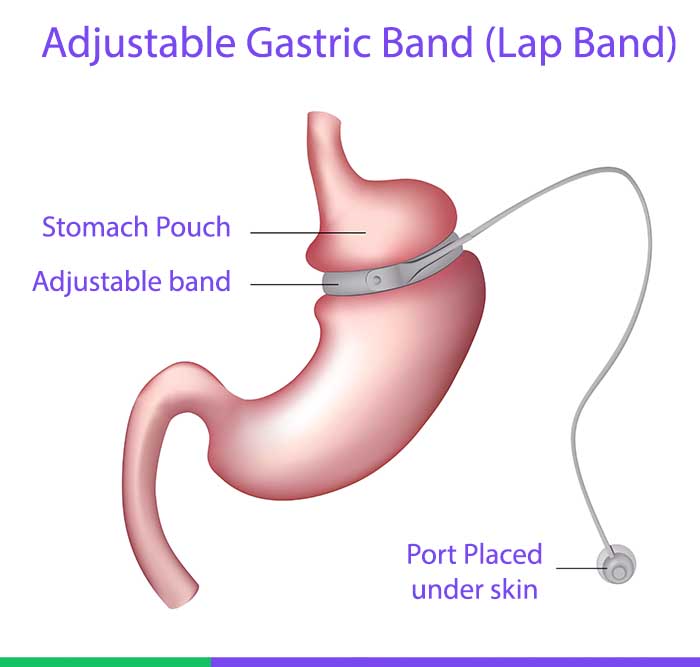


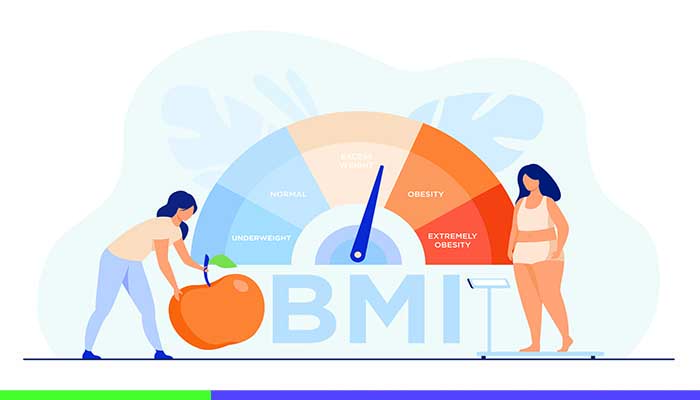
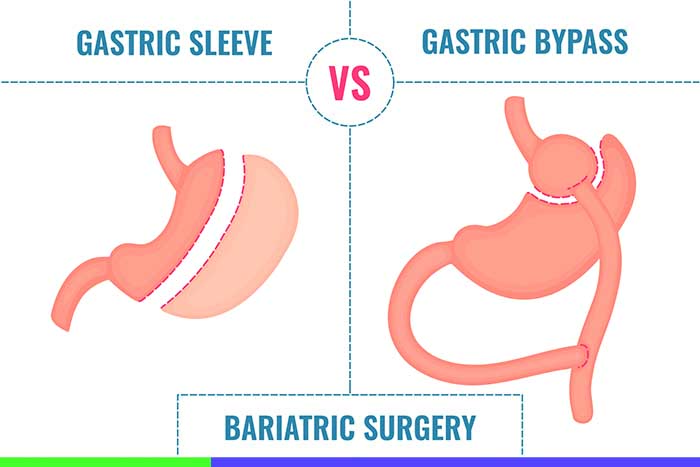 Gastric Sleeve vs. Gastric Bypass
Gastric Sleeve vs. Gastric Bypass


